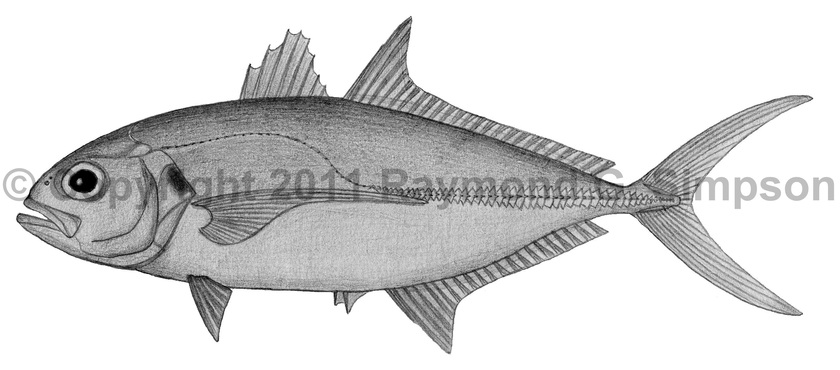
Common Name
Blue Runner
Year Described
Mitchill, 1815
Identification
Dorsal Fin: 8 spines in first lobe, followed by I, 22-25
Anal Fin: 2 spines separate from rest, followed by I, 19-21
Pelvic Fin: I, 5
Gill Rakers: 10-14 upper, 25-28 lower
Vertebrae: 10 precaudal, 15 caudal
Elongate, compressed, and fairly deep-bodied, with a large head, blunt snout, and a moderate eye (4.0-5.0 times in HL). Adipose eyelid moderate. Jaw extends to middle of eye. Teeth in two rows on the upper jaw, in a single row on the lower jaw. Pectoral fins falcate, longer than head. Spiny dorsal fin lower than lobe of second dorsal fin. Anterior lobe of second dorsal and anal fin raised. Tail deeply forked. Lateral line with an strong anterior arch and a straight posterior portion with 46-56 scutes. Small cycloid scales on entire body, including entire chest. Bilateral caudal keels present. Hyperostosis greatly enlarged in adults.
Color
Greenish-blue to olive dorsally, grading to silvery below. Often has a golden sheen on ventral surface. Dark blotch often present on upper gill cover. Fins clear to dusky. Caudal fin sometimes yellowish with dark tips. Juveniles with 7 dark body bands (thicker than light interspaces).
Size
Common to 35cm. Maximum size to 62cm.
Habitat
Coastal and inshore, pelagic or near the bottom. Forms schools. Young associate with flotsam.
Range
Nova Scotia to SE Brazil, including Bermuda and the Caribbean islands.
References
Smith-Vaniz, W.F. 2003. Carangidae (pp 1426-1468). In: Carpenter. 2003. The living marine resources of the Western Central Atlantic v. 3.